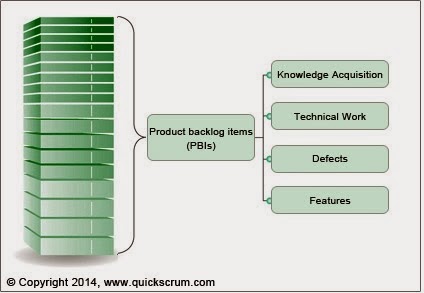The Product Backlog
In
scrum, the product backlog consists
of all the user stories, or the set of requirements which are essentially
required to manufacture the product in totality. By totality, we mean a product
which possesses all the attributes as requested by the end users so that they
can use it in an effective and meaningful manner to carry out their tasks or
activities. In reality, the user stories are the same as product backlog items.
While the product backlog item or the “PBI” is the actual terminology recommended
and used by scrum, in simple language it is often referred to as a “user story” by the team members. In
practice, the product to be developed is actually owned by the stakeholders or
the investors who have put in money into the project. Since their role is to
“own” and “decide” about what kinds of features and functionalists should be
incorporated into the product, it is not practical for all the stakeholders to
carry out the development process by addressing the team members on an
individual basis. It is not practical to do so. Therefore, they appoint a
person who acts in the capacity of a “product owner” and who represents their interests while the product is being
developed and scrum methodology is being
implemented in the project.
 |
| Product backlog |
At
the onset when a scrum project is planned, the product owner first of all
clearly understands about the features and functionality to be provided in
the product. Subsequently, he or she breaks up the entire product into its
constituent parts, which can be later “assembled” to “remake” the product when
all the constituent parts are developed individually. The parts actually form
the PBIs in the product backlog. While the product backlog is being constructed
or compiled, it is necessary to determine how important the user stories are as
far as the final product is concerned. While some of the functionality associated
with a particular user story may be very important, quite a few of them may not
be so important from the end user or the market point of view. It becomes
necessary to prioritize the user stories depending upon what kinds of functionality and features they possess. The activity of prioritizing the
user stories or the PBIs is done by the product owner.
Moreover,
the product backlog contains the explanation and description of the functionality linked up with each user story. It is specifically explained in
what manner the user stories are to be developed by the development team
members during the sprint activity. Many times, the user story can also contain
the functional and non-functional aspects needed to understand the requirement in
a proper manner. The product backlog is very critical, and forms the “heart” of
all scrum related activities. It should be carefully prepared by the product
owner.